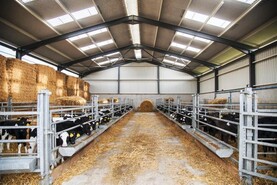TAMS stands for Targeted Agricultural Mechanisation Scheme and it has been running for a number of years now in several different forms. The most recent form is TAMS III.
TAMS is one of the CAP (Common Agricultural Policy) grant schemes that seeks to improve the conditions on farms for both farmer and livestock from a labour efficiency, safety, environmental and animal welfare point of view.
TAMS allows farmers to invest in their farm, be it improving their livestock housing, slurry storage, or purchasing better equipment and will then reimburse the farmer with a grant (usually between 40% and 60%) on the cost.
How TAMS works depends on what exactly you are looking to buy or build. The first step is making an application, which is usually completed by a farm adviser.
When applying for TAMS aid for a fixed item, such as a shed, planning permission will have to be granted before you send in your application. Your application may have to also include farm yard sketches of where you are building.
Roughly three months after the closing date for applications you should then receive an acceptance letter.
You can only start building works after receiving this, and all works will have to be carried out in the time frame that the department tell you, which is usually 12 months from when you receive your acceptance letter.
Schemes within TAMS
TAMS itself is broken up into 10 different schemes depending on what the item is. For most animal housing, slurry storage and silage storage, farmers will apply for the AWNSS (animal welfare and nutrient storage scheme).
With TAMS III, several new schemes have emerged such as the FSCIS (farm safety capital investment scheme) and the WFCIS (women farmer capital investment scheme). The SCIS (solar capital investment scheme) is also a popular one which allows farmers to install solar panels on the roofs of their farm sheds (read more about solar panels on p13).
Reference costs and ceilings
Each specific item or investment has a reference cost, which is what the department have calculated it will cost you to purchase or build your investment. This may be based off a unit (cattle weighing scales) or can be based off the size or volume of the investment (length, area or volume).
For example, when calculating a slatted shed with a creep and a feed passage, each area has to be accurately measured as there are different reference costs for the slatted area, creep area and feed passage area.
When a farmer is submitting their receipts for the completed works, they will be paid on either the reference cost or the actual cost, whichever is lower, and all submitted prices are excluding VAT (value added tax).
A ceiling might be what’s above your head when you look up in a room, but it also the maximum amount of money you can spend when it comes to TAMS!
For a farmer applying on their own, the maximum money you will get grant aid for is €90,000, but if a farmer is in partnership with someone else (their son/daughter, wife/husband) they can spend up to €160,000.
Grant rates
The normal grant rate under TAMS is 40%, but some schemes allow for a higher grant rate of 60%. Young farmers who have completed their Green Cert exams can apply for the YFCIS and receive 60% of their spend back in a grant. Women farmers (between the ages of 18 and 66) can also qualify for this higher grant rate.
A new scheme in TAMS is the Farm Safety scheme (FSCIS). All farmers can obtain a grant of 60% when applying under this scheme, which includes cattle crushes, sheep pens and replacing old slats.
The Solar Capital Investment Scheme (SCIS), also qualifies for the 60% grant rate and is explained below.






 This is a subscriber-only article
This is a subscriber-only article










SHARING OPTIONS: